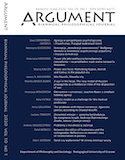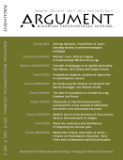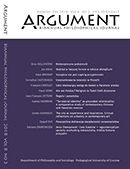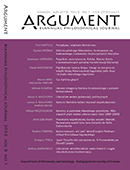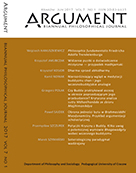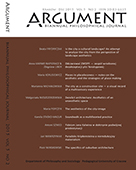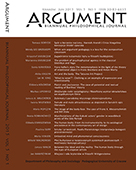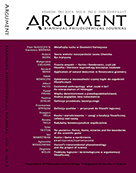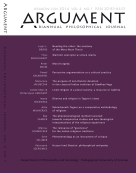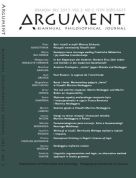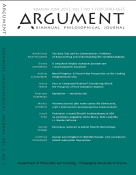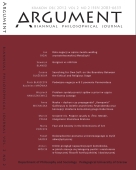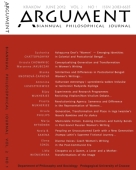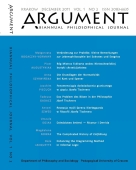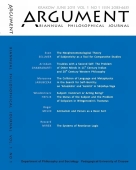e-ISSN 20841043
Kraków, December 2016, volume 6, number 2
SPIS TREŚCI

Temat wiodący numeru:
God and mysticism — in the circle of phenomenology
Redaktorzy: Wojciech Hanuszkiewicz, Paweł Sznajder
Redaktor tematyczny: Tadeusz Gadacz

Wprowadzenie
Introduction to the issue (Wojciech HANUSZKIEWICZ, Paweł SZNAJDER) (267-270)
Artykuły i rozprawy
Angela Ales BELLO, On the divine in Husserl (271-282)
Abstrakt
The paper deals with the ways in which Edmund Husserl develops the question of God. Six ways to reach God are shown as present in Husserl’s writings, some of them seem to be very close to the traditional philosophical ways to go as far as God (the objective and the subjective ways) others are very original, in particular the way that starts from the analysis of the hyletic sphere of the human being, a sphere which is present in all the reality too. At last it is possible to notice Husserl’s interest in the mystical approach to God.
Słowa kluczowe: epoche; lived experience; transcendental reduction; nality; interiority; monad; ethics; hyle; mystics; phenomenology of religion
Jaromir BREJDAK, Bóg spoza nawiasu egzystencji. Max Scheler – mistyka czy fenomenologia aktowego zjednoczenia? (283-298)
Abstrakt
God beyond of the bracket of existence. Max Scheler mysticism or phenomenology of actual unification: This article presents in the first part the concept of Schelerian phenomenology of religion and claims that pre‐phenomenon of Holiness could not be take in the bracket of existence as usual because the religious act raised by Holiness itself is an heteronomic act of God‐Holiness realized in the man and giving evidence of the existence of its Reasoner. In the second part of this article two types of unity are presented: unity due to joint feeling with others (unmittelbares Mitfühlen — “Two parents stand beside the dead body of a beloved child”) and unity due to co‐operation of personal acts (Mitvollzug — “I live, yet not I, but Christ in me”). This two types of unities present the Other in a primordial way, which launched several criticism against Max Scheler’s mysticism. Phenomenology of act and mysticism seems to merge together in one point, calling Maieutic Birth, a their method becomes enactment of meaning (Vollzugstheorie der Bedeutung — Karl Friedrich Gethmann).
Słowa kluczowe: mysticism; phenomenology of act; Holiness; God‐Person; person‐act; unity of joint feeling with others (unmittelbares Mitühlen); cooperation of personal acts (Mitvollzug); joint person (Gesamtperson); maieutic birth
Eckard WOLZ-GOTTWALD, Die Kehre als völlige Umwendung des Menschen. Von der Verwirklichung des „mystischen” Antriebs der Phänomenologie im Denken Martin Heideggers (299-312)
Abstrakt
The turn as the complete transformation of a human being. On the realization of the “mystical” impetus of phenomenology in Martin Heidegger’s thought: The article first outlines Edmund Husserl’s idea of “complete transformation” (völlige Umwendung) and the philosophy of “the turn” (Kehre) of Martin Heidegger. In the following chapter it is shown that you can understand both Husserl as well as Heidegger in the light of “the essential turn” in the German mysticism of the fourteenth century. In this way it becomes clear that Husserl’s idea of a “complete transformation” seems to be a forgotten “mystical” impetus of phenomenology, which was much more realized by Martin Heidegger than by Husserl. In this way Heidegger’s philosophy of “the turn” appears as an important modern approach of the mystical philosophy of transformation.
Słowa kluczowe: Martin Heidegger; Edmund Husserl; phenomenology; complete transformation; the turn; mysticism; philosophy of transformation
Andrzej SERAFIN, Heidegger’s phenomenology of the invisible (313-322)
Abstrakt
Martin Heidegger has retrospectively characterized his philosophy as “phenomenology of the invisible”. This paradoxical formula suggests that the aim of his thinking was to examine the origin of the phenomena. Furthermore, Heidegger has also stated that his philosophy is ultimately motivated by a theological interest, namely the question of God’s absence. Following the guiding thread of those remarks, this essay analyzes the essential traits of Heidegger’s thought by interpreting them as an attempt to develop a phenomenology of the invisible. Heidegger’s attitude towards physics and metaphysics, his theory of truth, his reading of Aristotle, his concept of Dasein, his understanding of nothingness are all situated within the problematic context of the relation between the invisible and the revealed. Heidegger’s thought is thereby posited at the point of intersection of phenomenology, ontology, and theology.
Słowa kluczowe: Martin Heidegger; phenomenology; ontology; theology; physics; metaphysics; truth; nihilism
Joachim PIECUCH, Abgeschiedenheit Mistrza Eckharta w fenomenologicznej wykładni Bernharda Weltego (323-340)
Abstrakt
Abgeschiedenheit Meister Eckhart in the phenomenological interpretation of Bernhard Welte: The basis of analyzes carried out in the article is the work of Bernhard Welte: Meister Eckhart. Gedanken zu seinen Gedanken. The central subject of research is the idea Abgeschiedenheit (“isolation”). Following the interpretation of Welte it has been considerated a phenomeno‐ logical description on two ways. From the practical experience, as a modus vivendi a religious man, and from the theoretical, as speculative thought. Theoretical considerations consist of analysis of the concept of truth and goodness, which Eckhart identifies with the idea of God. Welte shows that these concepts of medieval thinker at the starting point considerations are still sink in the schemes of metaphysical thinking, but in the next stages of its argumentation he overcome metaphysical discourse. The purpose of the article, guided by the suggestion Weltes interpretation, is to show ways of reaching the source forms of religious experience. At the same time the text raised the issue of problematic use formulas of mystical union and noticed parallels have been taking place between the method of phenomenological reduction and the idea of Abgeschiedenheit.
Słowa kluczowe: Meister Eckhart; German philosophy; metaphysics; religious experience; Abgeschiedenheit (“isolation”)
Rafał S. NIZIŃSKI, From the perception of things to the hypothesis of God. Is Xavier Zubiri a mystic? (341-356)
Abstrakt
There are two fundamental questions that this paper tries to answer: how Zubiri knows God, and whether we can consider his philosophy to be mysticism. The greatest part of the analysis considers the last ten years of his philosophical activity. The first part of the paper analyzes the mature form of his method, which Zubiri revealed in his Trilogy. A brief presentation is made of primordial apprehension, logos and reason. Zubiri’s method goes beyond orthodox phenomenology, because he finds a need also to include metaphysics. The second part of the article applies this method in order to know God. It begins with an analysis of the person in the process of construction of its I. Zubiri analyzes this mostly in Man and God. We can access God only on the metaphysical level of knowledge. On this path he rejects logic and speculation. On our way to know God we must confront the presumed sketch of God with human personal life. We can discover human life only by following strictly the sui generis phenomenological method. The conclusion that Zubiri reaches is that there is a personal absolute God, who influences humans in the construction of the I through the reality of things. On certain conditions, we can call Zubiri’s approach to philosophy a mystical one. This is due to the constant action of God creating a certain tension between the person and reality and a need for a personal answer to the divine action.
Słowa kluczowe: reality; relegation; the power of the real; person; enigma; reason; mysticism
Joanna SARBIEWSKA, (Post)sekularna filozofia negatywna, media wizualne i ekstasis (dekonstrukcja jako wariant neofenomenologii) (357-372)
Abstrakt
(Post)secular negative philosophy, visual media and ecstasies. Deconstruction as a variant of neophenomenology: The author proposes a neophenomenological interpretation of the late Jacques Derrida’s deconstruction, by bringing it into the light of (post)secular negative philosophy and indicating the application of its mystic/ecstatic implications on a media techno-vision basis. In this conceptualization, deconstruction/negation, as an ,epoche strategy, not only denudes (kenosis) cognition of the idolatry, characteristic of the traditional methaphysics of presence and the dogmatic religion, but also suspends “the source” itself (the Offenberkeit register), and thus, causes the experience of radical emptiness (chora) as a condition of an opening to the Impossible. The author, by presenting the concept of negative image, demonstrates that technology visual media provide a suitable space (groundlessness) for Impossible to manifest itself in post-industrial culture.
Słowa kluczowe: deconstruction; neophenomenology; negative philosophy; technology visual media; apophatic mysticism; Impossible; Martin Heidegger; Jacques Derrida
Piotr PŁANETA, Niedualna uważność a stan samādhi w kontekście badań neurofenomenologicznych (373-390)
Abstrakt
Nondual awareness and the state of samādhi in the context of the neurophenomenological research: The aim of this paper is to compare various meditative states, such as Buddhist dhyāna‐s, yogic nirbīja samādhi and nondual awareness (Tib. gñis‐med). The primary sour‐ ce texts I refere to are Yogasūtras of Patañjali, Ānāpānasmṛtisūtra (MN 118), Samādhisūtra (AN 41), The Tibetan Yogas of Dream and Sleep. I also discuss some relevant claims of contemporary empirical studies. First, I define the key terms used in Eastern meditation studies as well as in neurophenomenology, a contemporary method applied to examining the meditative states of mind, such as samādhi, dhyāna, and śamatha. Inspired by Shinzen Young, I distinguish three groups of meditative states that might be identified with nondual awareness. These three groups are: the second, the third and fourth Buddhist dhyāna being equivalent to nirvicāra samādhi and nirānanda samādhi in the classical Indian yoga; nirbīja samādhi and nondual awareness, typical to the Mahayāna contemplative traditions. I explain why we can recognize each of the above states as nondual awareness and how they differ from each other. Then, I make a comparison between meditation practice explained in Ānāpānasmṛtisūtra and nondual awareness presented in the Tibetan Buddhism. Besides, I discuss the above kinds of mental states in terms of recent neurophenomenological findings. While doing so, I am trying to demonstrate that our understanding of meditation can benefit from the empirical studies which help us to objective this kind of subjective experience, to some degree, if they are given an adequate place in our study.
Słowa kluczowe: meditation; dhyāna; nirbīja‐samādhi; classical Sāṁkhya‐Yoga; Theravada Buddhism; Tibetan Buddhism
* * *
Iva SVAČINOVÁ, Pascal’s wager: tracking an intended reader in the structure of the argument (391-412)
Abstrakt
Pascal’s wager is the name of an argument in favor of belief in God presented by Blaise Pascal in §233 of Thoughts. Ian Hacking (1972) pointed out that Pascal’s text involves three different versions of the argument. This paper proceeds from this identification, but it concerns an examination of the rhetorical strategy realized by Pascal’s argumentation. The final form of Pascal’s argument is considered as a product that could be established only through a specific process of persuasion led with respect to an intended reader with a particular set of initial beliefs. The text uses insights from the pragma‐dialectical approach to argumentation, especially the concept of rhetorical effectiveness of particular choices from the topical potential. The argumentation structure of Pascal’s wager is considered to be a reflection of the anticipated course of dialogue with the reader critically testing the sustainability of Pascal’s standpoint “You should believe in God”. Based on the argumentation reconstruction of three versions of the argument, Pascal’s idea of opponent/audience is identified. A rhetorical analysis of the effects of his argumentative strategy is proposed. The analysis is based on two perspectives on Pascal’s argument: it examines the strategy implemented consistently by all arguments and the strategy of a formulation of different versions of the wager.
Słowa kluczowe: argumentation structure; Pascal’s wager; pragma‐dialectics; rhetorical analysis; strategic maneuvering; topical potential
Zbigniew WOLAK, Uwagi o pojęciu przyczynowości u Jana Łukasiewicza (413-428)
Abstrakt
Remarks on the Jan Łukasiewicz’s concept of causality: Jan Łukasiewicz, a prominent Polish logician and philosopher, dealt with the scientific analysis of the concept of cause using logic. He wanted first and foremost to construct a definition, which reconciles the irreversibility of causal relationship to the exclusion of time sequence. In this article, I show that his attempts led to many contradictions, paradoxes and inconsistencies between Łukasiewicz’s definitions and commonly recognized examples of causality, even those given by the author himself. First, I present the semantic and formal aspects of the definition proposed by him, and then I analyze examples, most of them proposed by the author. The main charges against his concept of causality are: the ambiguity of the concept of necessity; exclusion “for reasons of terminological” some causal phenomena from the range specified by the definition; paradoxes such as: the existence of the world is the cause of the existence of God; baseless demand, different subjects, and different features for cause and effect; disregard of the defnitive difference between post hoc and propter hoc; unjustified requirement of affirmative statements expressing a possession of attributes. The critique presented in this article is incomplete, but its function is to indicate both the value of logical analysis of philosophical concepts, and the dificulties of which such an analysis can entangle. Such an analysis can sometimes complete the process of defining certain concepts, but more often it provides an opportunity for further discussion and a better overall understanding.
Słowa kluczowe: logical analysis; necessity; induction; implication; the paradox of causality;, irreversibility; post
hoc and propter hoc
Przemysław SPRYSZAK, O etyce niezależnej Tadeusza Kotarbińskiego (429-454)
Abstrakt
On independent ethics of Tadeusz Kotarbiński: In this paper I briefly discuss principles of “independent ethics” formulated and popularized by the Polish philosopher Tadeusz Kotarbiński. I focus on the notion of “conscience” which seems to play a fundamental role in this moral theory.
Słowa kluczowe: morality; secular ethics; conscience
Karolina GLAZOR-POMYKAŁA, Estetyka a granice języka. Ludwig Wittgenstein i Arthur C. Danto (455-476)
Abstrakt
Aesthetics and borders of language. From Ludwig Wittgenstein to Arthur C. Danto: The article is an attempt to pinpoint the areas of Ludwig Wittgenstein aesthetic thought, in which he is crossing the borders principally imposed upon the method and the language of his philosophy. I am directing my attention to metaphysical and mystical motifs of his reflection devoted to aesthetics, the essence of art and the essence of reality. I wish to discuss this issue based on the texts of Arthur C. Danto containing analysis of chosen notions of Wittgenstein’s aesthetic investigations. Additionally in this matter I am appealing to appropriate theses of Leszek Sosnowski and Wojciech Sady, concerning above issues.
Słowa kluczowe: Ludwig Wittgenstein; Arthur C. Danto; family resemblance; language game; language of logic; language of philosophy; essence of art; essence of reality
Michał MARZEC-REMISZEWSKI, Czy wnioski z eksperymentów naukowych badających wolną wolę są uzasadnione? Przegląd i analiza krytyki eksperymentów Benjamina Libeta i Johna-Dylana Haynesa (475-492)
Abstrakt
Are the conclusions of the scientific experiments investigating free will justified? The analysis of the criticism concerning Libet’s and Haynes’ experiments: Scientific experiments which try to examine free will are faced with various critical arguments — both philosophical and methodological. In this article I will present the most important and the most interesting critical arguments attacking two the most influential experiments: Benjamin Libet experiment and John‐Dylan Haynes experiment. In the first part of the article I will consider a particular criticism of Libet paradigm, which loses its importance in context of Haynes paradigm. Next I will present critical arguments which attack both Haynes and Libet experiments (and probably all other psychophysiological experiments facing free will problem). Because of this analysis I will consider informative value of presented experiments in context of existence of free will.
Słowa kluczowe: free will; Libet’s experiment; Haynes’ experiment; determinism
Nauczanie filozofii, wykłady
Jean LECLERCQ, Grégori JEAN, Nowe rozumienie życia podmiotowego: fenomenologiczny projekt Michela Henry’ego (przeł. Wojciech STARZYŃSKI) (493-504)
Abstrakt
A new understanding of subjective life. The phenomenological project of Michel Henry:
The phenomenological tradition is commonly understood as the domain of “philosophy of the subject”, and in this regard it is often criticized in contemporary thought. In respect to it, the originality of Michel Henry is to enter into this tradition by formulating to it an inverse objection: a mistake of the “historic” phenomenology is that it has not been able to conceive the subject in its own being or better, in its “interiority”. The aim of this paper is to determine the meaning and scope of such criticism, the development of its consequences, not only regarding the positive concept of subjectivity but also in the sense of opening its possibilities to renew the understanding of artistic phenomenon.
Słowa kluczowe: Michel Henry; Jean‐Paul Sartre; phenomenology; subjectivity; interiority; creation
Okiem filozOFFa
Piotr BARTULA, Filozoficzna prognoza Globalnego Ocieplenia Możliwego Świata Międzyludzkiego. Opracował Zespół Filozofii Globalnej Myślicieli Wschodu, Zachodu, Północy i Południa [w skrócie ZFGM] (505-508)
Recenzje i noty
Jerzy Machnacz, Monika Małek-Orłowska, Krzysztof Serafin (Ed.), The Hat and the Veil. The Phenomenology of Edith Stein / Hut und Schleier. Die Phänomenologie Edith Steins Rec. Paweł SZNAJDER (509-518)
Słowa kluczowe
Edith Stein, phenomenology, thomism, anthropology, ways to God
Sprawozdania
Marzenna JAKUBCZAK, Gdzie spotykają się filozofowie Wschodu i Zachodu? Refleksje o filozofii porównawczej i konferencji w Honolulu „11th East-West Philosophers’ Conference” (519-528)
Abstrakt
Where do the East and West philosophers meet? Reflections on the 11th East‐West Philosophers’ Conference, Honolulu: The paper presents the idea of cross‐cultural philosophy, which have inspired the organizers of the cyclic global conferences held at the University of Hawai’i at Mānoa, USA, since 193 First, the author discusses some definitions of the comparative method applied in contemporary philosophy and promoted, among others, through the project of the “East‐West Philosophers’ Conference”. Then, she reports the major themes and panel topics raised during the eleventh conference organized in Honolulu, May 25–31, 2016.
Słowa kluczowe: comparative philosophy; cross‐cultural philosophy; world philosophies; polilogue; University of Hawai’i at Mānoa; East‐West Philosophers’ Conference
Autorzy tomu
Pełny tekst (531-532)
Zapisz
Zapisz
Zapisz
Zapisz
Zapisz
Zapisz
Zapisz
Zapisz


